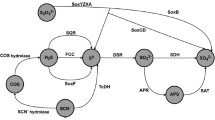Abstract
From a heterotrophic bacterium,Xanthomonas sp. DY44 which was previously reported to oxidize hydrogen sulfide (H2S) to polysulfide, cytochromec-555 (cyt.c-555) responsible for oxidation of sulfide was purified by DEAE-Toyopearl and Sepadex G-75 column chromatography. Cyt.c-555 with a molecular weight of 12,500 showed maximum absorption at 555 nm (α-peak), 522 nm (β-peak) and 417 nm (γ-peak) for the reduced form which was prepared by addition of Na2S2O4. Cyt.c-555 was also reduced by addition of sulfide (Na2S and H2S), and the oxidized products of sulfide by cyt.c-555 was identified as polysulfide. The reduced form of cyt.c-555 was suggested to be oxidized coupled with cyt.c oxidase which is tolerant to sulfide.
Similar content being viewed by others
References
Sublette, K. L. and J. T. Syverster (1987) Oxidation of hydrogen sulfide byThiobacillus denitrificans: desulfurization of natural gas.Biotechnol. Bioeng. 29: 249–257.
Rodrigues-Leiva, M. and H. Tribusch (1988) Morphology of bacterial leaching patterns byThiobacillus ferrooxidans on synthetic pyrite.Arch. Microbiol. 149: 401–405.
Cho, K. S., M. Hirai, and M. Shoda (1991) Removal characteristics of hydrogen sulfide and methanethiol byThiobacillus sp. isolated from peat in biological deodorization.J. Ferment. Bioeng. 71: 44–49.
Cho, K. S., M. Hirai, and M. Shoda (1991) Degradation characteristics of hydrogen sulfide, methanethiol, dimethyl sulfide and dimethyl disulfide byThiobacillus thioparus DW44 isolated from peat biofilter.J. Ferment. Bioeng. 71: 384–389.
Larkin, J. M. (1980) Isolation ofThiotrix in pure culture and observation of a filamentous epiphyte onThiotrix, Curr. Microbiol. 4: 144–158.
Nelson, D. C. and H. W. Jannasch (1983) Chemoautotrophic growth of a marineBeggiatoa in sulfide-gradient cultures.Arch. Microbiol. 136: 262–269.
Cannon, G. C., W. R. Strohl, J. M. Larkin, and J. M. Shively (1979) Cytochromes inBeggiatoa alba, Curr. Microbiol. 2: 263–266.
Suylen, G. M. H., G. C. Stefess, and J. G. Kuenen (1986) Chemolithotrophic potential of aHyphomicrobium species, capable of growth on methylated sulphur compounds.Arch. Microbiol. 146: 192–198.
Kusai, K. and T. Yamanaka (1973) Cytochromec (553, Chlorobiumthiosulfatophilium) is a sulphide-cytochromec reductase.FEMS Lett. 34: 235–237.
Steinmetz, M. A. and U. Fisher (1981) Cytochromes of the non-thiosulfate utilizing green sulfur bacteriumChlorobium limicola, Arch. Microbiol. 130: 31–37.
Fukumori, Y. and T. Yamanaka (1979) Flavocytochromec of Chromatiumvinosum, some enzymatic properties and subunit structure.J. Biochem. 85: 1405–1414.
Hansen, T. A. and H. van Gemerden (1972) Sulfide utilization by purple nonsulfur bacteria.Arch. Microbiol. 86: 49–56.
Then, J. and H. G. Truper (1983) Sulfide oxidation inEctothiorhodospira abdelmalekii Evidence for the catalytic role of cytochromec-551.Arch. Microbiol. 135: 254–258.
Oren, A. and E. Paden (1978) Induction of anaerobic photoautotrophic growth in the cyanobacteriumOscillatoria limnetica.J. Bacteriol. 133: 558–563.
Cho, K. S., I. Kuniyoshi, M. Hirai, and M. Shoda (1991) A newly isolated heterotrophic bacterium,Xanthomonas sp. DY44, to oxidize hydrogen sulfide to polysulfide.Biotechnol. Lett. 13: 923–928.
Cho, K. S., M. Hirai, and M. Shoda (1992) Degradation of hydrogen sulfide byXanthomonas sp. strain isolated from peat.Appl. Environ. Microbiol. 58: 1183–1189.
Steinmetz, M. A. and U. Fisher (1982) Cytochromes of the green sulfur bacterium Chlorobiumvibrioforme f. thiosulfatophilum. Purification, characterization and sulfur metabolism.Arch. Microbiol. 131: 19–26.
Knaff, D. B. and B. B. Buchanan (1975) Cytochrome b and photosynthetic sulfide bacteria.Biochim. Biophys. Acta. 376: 549–560.
Laemmli, U. K. (1970) Cleavage of structural proteins during the assembly of the head of bacteriophage T4.Nature 227: 680–685.
Bradford, M. M. (1976) A rapid sensitive method for the quantitation of microgram quantities of protein utilizing the principle of protein-dye binding.Anal. Biochem. 72: 248–254.
Yamanaka, T. (1986), Energy mechanisms of microorganisms, Gakkaisyuppan center, pp. 4–6, Tokyo.
Cotton, F. A. and G. Wilkinson (1980), Advanced inorganic chemistry, 4th ed., p. 513, New York.
Author information
Authors and Affiliations
Corresponding author
Rights and permissions
About this article
Cite this article
Cho, KS., Park, SJ. Some characteristics of cytochromec-555 isolated from sulfide oxidizingXanthomonas sp. DY44. Biotechnol. Bioprocess Eng. 2, 33–37 (1997). https://doi.org/10.1007/BF02932460
Issue Date:
DOI: https://doi.org/10.1007/BF02932460




